The Japan Snake Center isn’t really a haikyo, or it shouldn’t be. An active facility with a rather steep 1000 yen entry fee, some of Japan’s foremost experts on snakes come here to work. They hold bring-your-snake-day pet contests and open lectures on measures dealing with Japan’s poisonous snake, the mamushi. Not surprisingly, it’s also a research centre for snake venom and employees give live talks about various serpent species.
Sounds like a cool day out, no? It certainly wasn’t bad at all and there were no shortage of live snakes to view, but rotting away alongside the active facilities were several sheds of a sort. Wooden and splintering, yet strangely blending into the background of the institute. If you’re not there looking for them, you’d probably just walk right past.
But we were, of course. Intrepid explorers bent on finding ourselves an abandoned shack of rotting snake carcasses. Yes, that’s my hobby these days…
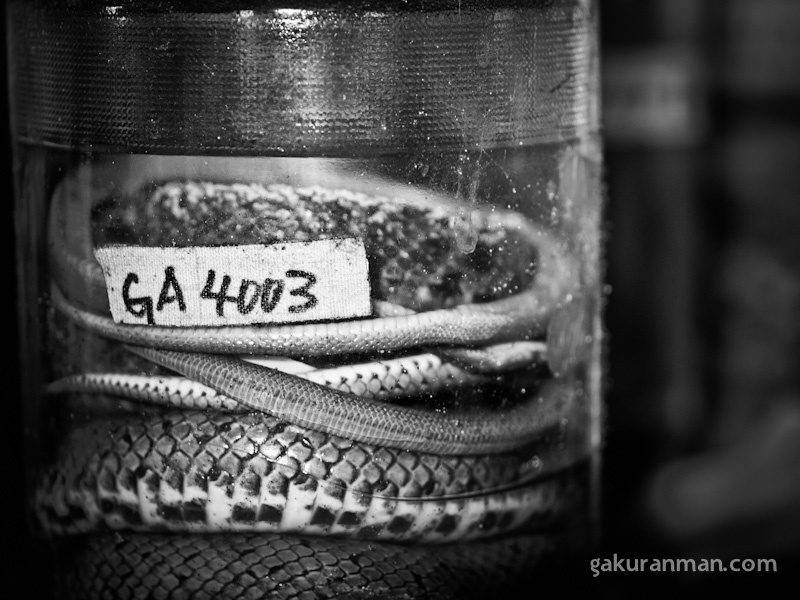
DIsappointed we were not. Surreptitiously slipping away from the main group who had gone to watch some poor snake specimen milked dry of its venom, we hurried through the overgrown grass towards the rear of the complex. It had to be the one – a building old and weathered, and looking distinctly forlorn. Reminiscent of the Doctor’s Shack itself.
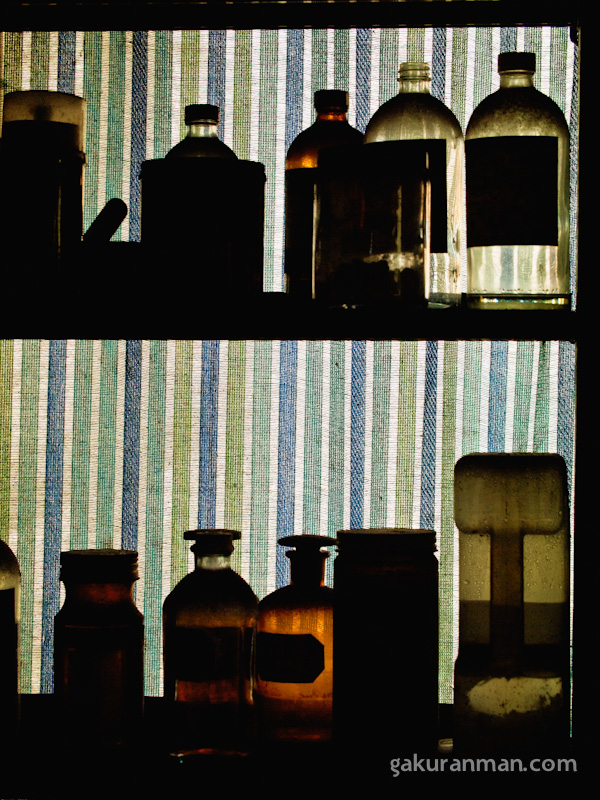
Bingo! We were in, sliding the old wooden door shut behind us. It was pretty cramped inside, but what lay before us was a world away from the enthusiastic man showing snakes to the tour group. Here, a dusty collection of glass containers, each filled with the sickening sight of hundreds of slimy bodies, all tied together in a mass orgy of colours. Magnificent. But…damn, what the hell..?
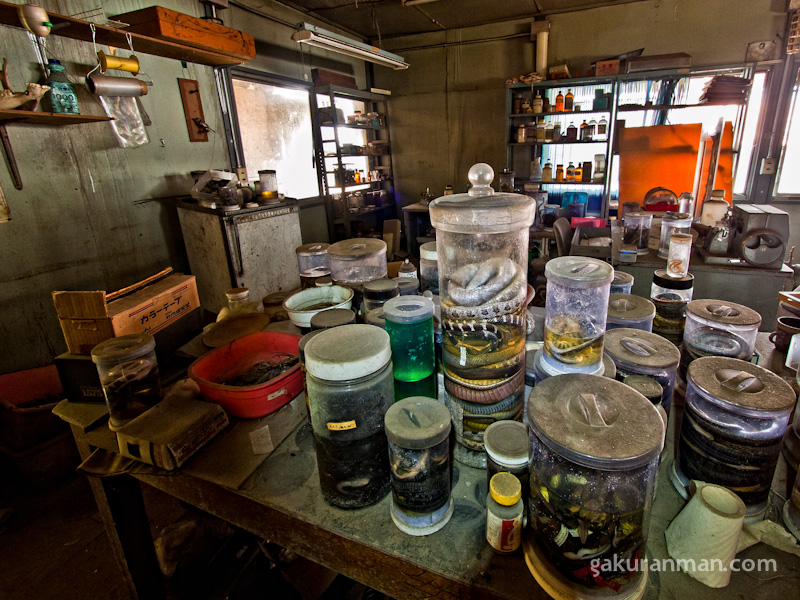
The gleeful child inside me was squirming in delight at the bizarre room that lay before u, but the adult in me was quite disgusted.
What on earth did they use all these snakes for? And why leave them here, preserved in liquids? Some kind of warped, mass burial.
Glinting, a small beaker caught my eye. The pink, decapitated head of one unfortunate victim.
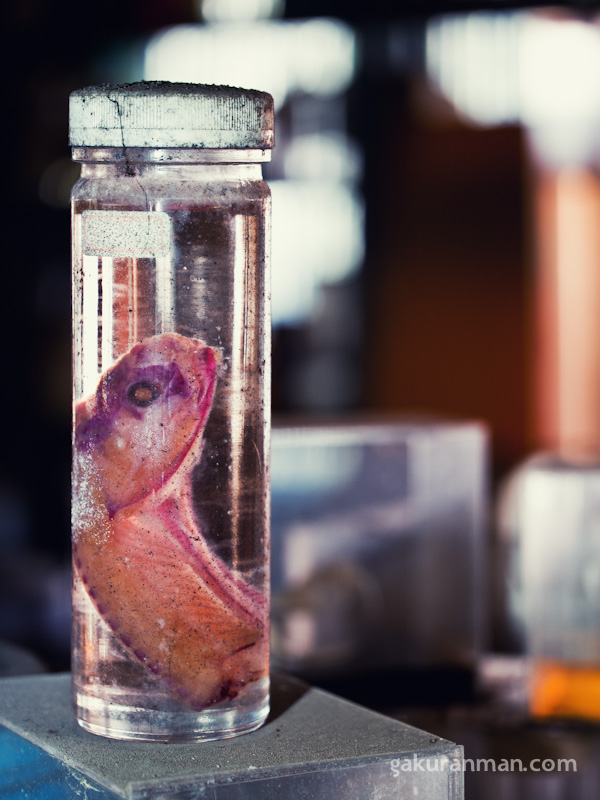
Next to it, a set of jaws with an impressive set of fangs, cleanly polished and well kept by the glass box around it.
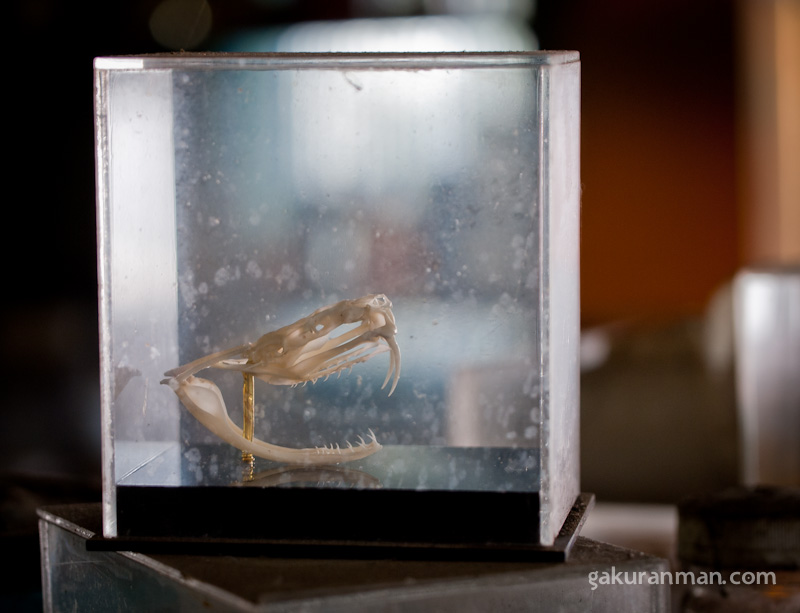
The room was also full of scientific equipment and curious specimens, oddly far more interesting than the ones displayed in the museum outside. These haphazard beakers, covered in a layer of grime from many years past, captivated me. A sterilisation box that looked like a reinforced microwave, test-tubes sitting unwashed in a sink and a microscope perched atop a darkened cabinet, glowing in the late afternoon light. It was certain research had gone on here, at least in the past. I couldn’t imagine it was used anymore though – perhaps they moved to the newer building? But then why leave this room as it was?
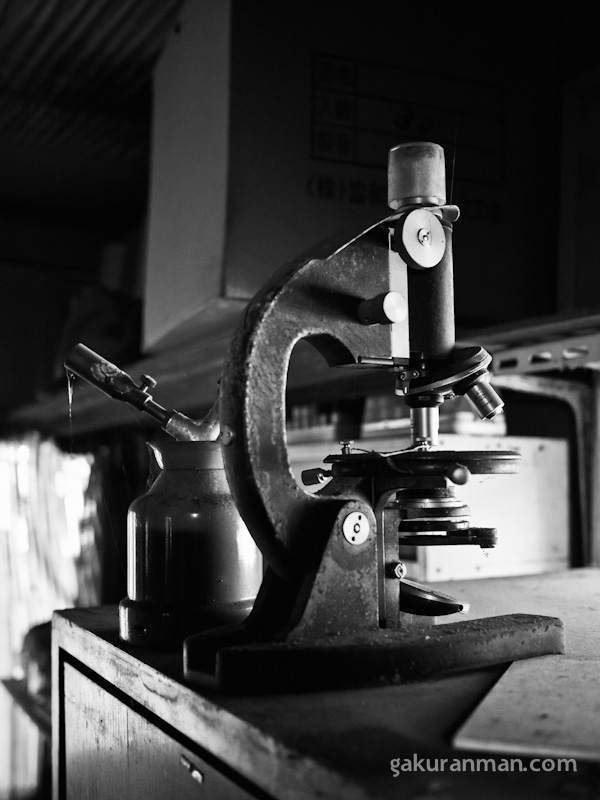
If it were possible, the sight in the adjoining room was even more terrible. A room full of huge, colourful plastic boxes. They wouldn’t have looked out of place in a children’s storage room, but upon peeking into the crates we were knocked back by an odour most foul.

It made the snakes stuffed into beakers and bottles seem almost gracefully preserved. Inside the coloured boxes were hundreds of serpent carcasses, all carelessly disposed of and left to rot. And by god, festering. The smell was overpowering – I could barely stand still to shoot a picture at all. Clutching the lid by the tips of my fingers though, I managed to get a few shots. It looked like there had once been tortoises stored there too, but now all that remained were empty husks. Most of the boxes were like this, piled high with snake skins and bodies, some kept in a dark, gooey liquid that smelt more putrid than the dry containers.

I didn’t linger for long and retreated back to the main room. Suddenly, a new appreciation for snakes in jars took hold of me. They don’t smell! …At least not half as bad as those boxes.
Inside the largest jar was a python, coiled up in what looked to be a deep slumber. In fact, if it hadn’t been for the telltale lifeless blue eye, I wouldn’t have been able to tell otherwise. Fresh as the day it died. Or was killed..?
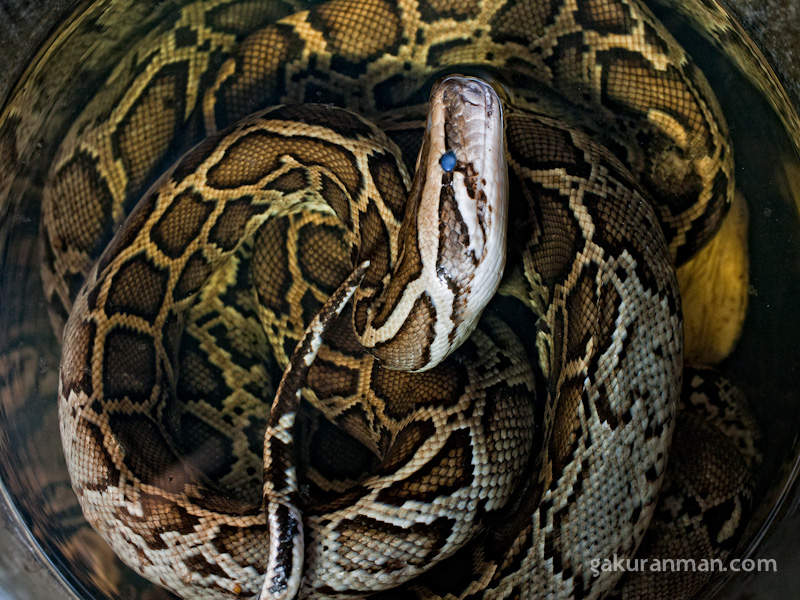
Another curious sight to behold was the long, wormlike creature held in a measuring tube. It reminded me more of a vicious stomach parasite or an alien creature that liked to burrow… Fascinating. But I couldn’t help wonder what would happen in an earthquake, as the tube was simply left stacked atop the pile of abandoned boxes. It was almost as it it were fresh, but it couldn’t be, judging by the grime on it.

Leaving the shack, we headed down the small hill towards another area of the centre. We’d heard of a second haikyo here – a cave, filled with old dinosaur exhibits. A rusty gate invited us toward it, squeaking slightly as we nipped inside. Sure enough, there was the King of the Dinosaurs itself, the Tyrannosaurus Rex. I thought he was looking rather grand, so I went vintage in the photo.
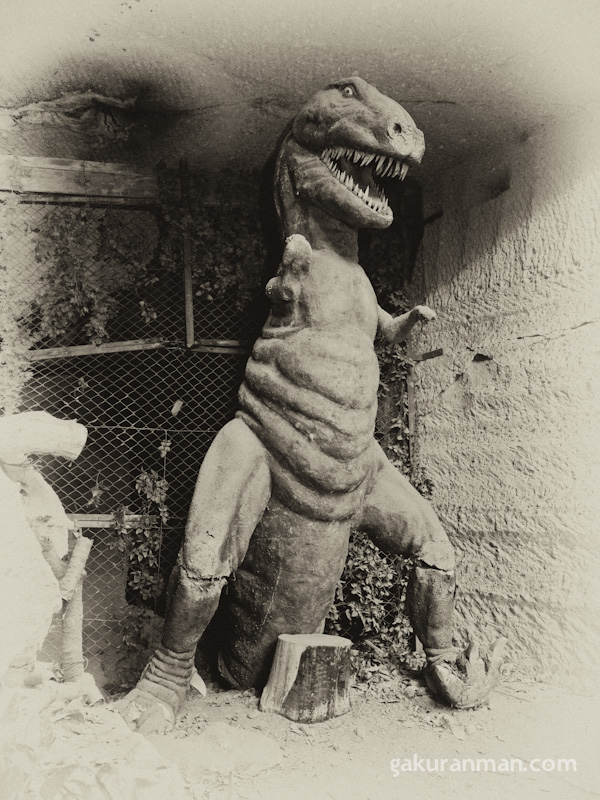
The cave was pitch black. After walking over stacks of old souvenirs, we had to stop. Before us, reflecting our torchlight, was a miniature lake. It stretched far back into the complex, down a tunnel I agonisingly wanted to explore. Evidently the place had flooded, as all the exhibits were submerged, including an old ice cream kiosk – Lady Borden Ice Cream. It looked like it could have been fun back in the day, but now, without a pair of waders at least, no-one is going to get very far. I wouldn’t be surprised if a few rogue water snakes were living in there…
With my torchlight, this was the best I could manage. Hope it gives an idea of what it was like.
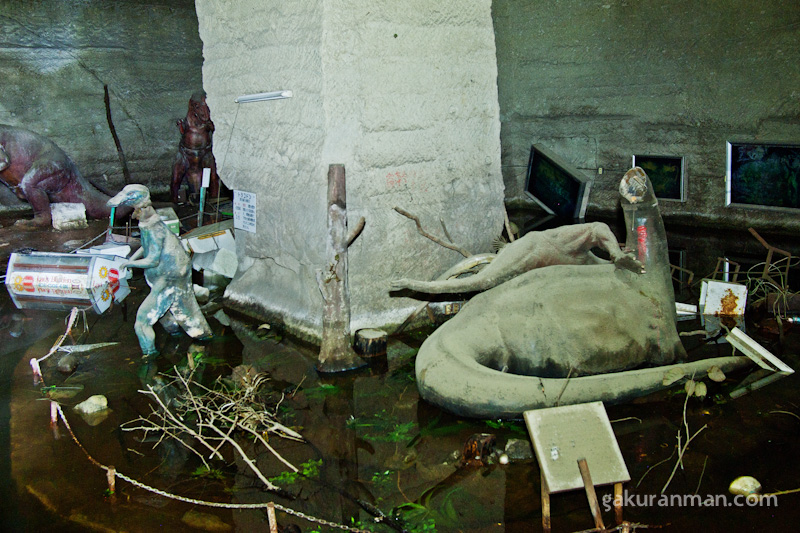
After browsing the real exhibits for a while, we strolled back outside the entrance. It had been a grand day out. Two unusual haikyo and a collection of bizarre creatures to behold. I reckon it would merit a return visit. Perhaps with those waders I used when exploring the Paris Catacombs…
But that was not all! To round off the day in style, just as I walked out the door of the gift shop, this tiny little Japanese treefrog plopped down in front of me. Looking particularly shaken, no doubt from being surrounded by his mortal enemies, I got the perfect chance to use my new macro lens, the Panasonic 45mm.
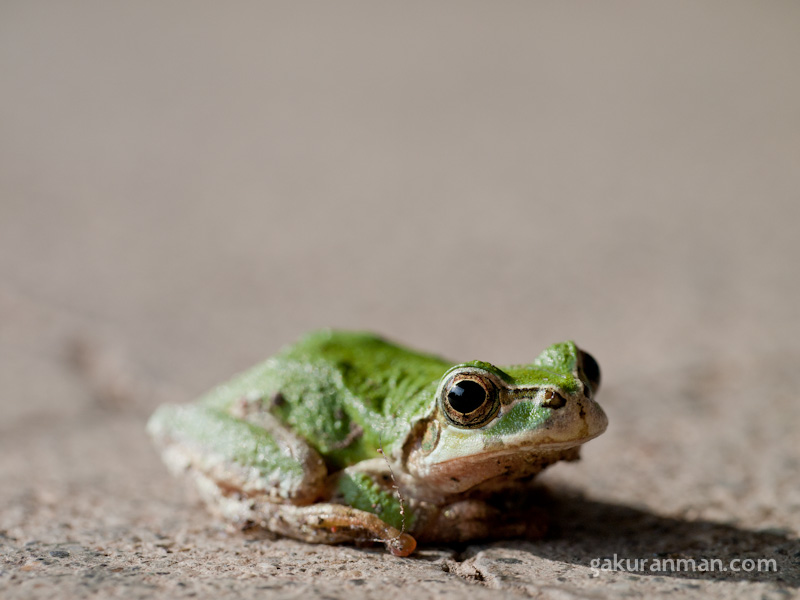
I couldn’t have asked for a better send-off, so I gladly returned the favour and took the little froggie to a nice, safe tree outside the malodourous, snake-infested complex. Ahh.









Disappointed to see that mess. I expected more from JSI. Interesting read never the less.
As a field biologist, your find is astonishing. There are countless creatures in the pictures that are not Japanese herps. I wonder, how many specimens in that place could be important to science, and neglect has rendered them useless. Could the place be rescued, it sure is interesting that back when it was working, many creatures died for the search of knowledge, I often question how ofeten this happens in famous museums of the world where hidden agendas were the main purpose of collecting data for “THE REAL PURPOSE”. This is one of such places. can you imagine the cost of building and maintaining a place like that. Too much, for today’s scientist ;-)
Right…I’m new to this site and this is the first blog I read. I must say…this is daaamn wicked!! In fact, I used to do these kind of activities: putting serpent carcasses in big bottles of formaldehyde when I was back in Sri Lanka. I did this serpent-in-a-bottle experiment for two purposes: One is for research and the other as an “old man’s hobby”. Above all, I am glad I found this site and glad ye got pro pictures :D ~ So says the Oldenyouth.
Haha. You actually did this sort of thing? What sort of things were you researching exactly?
*chuckle* WHAT, you mean there is something else to talk about in Japan besides Daiichi?!
Is this the へび センター in gunma?? I’ve been to the main facility….but if this is behind it I am appalled. Those poor reptiles.
It sucks doesn’t it? I hope they at least died painlessly…
Wow, what a horror to discover such things, both in the main room and the storage room. It seems likely that these animals weren’t treated all that humanely, which makes me sad because I like snakes just fine. Even more horrible to discover that so many were left carelessly to rot away. Then again, though, it does make for a morbidly fascinating haikyo.
How did you manage to sneak into this place, so close to an active facility? It seems amazing to me that such rot and ruin could sit so close to where people work.
It could well be. I reckon that they still have a use for it though. Many of the snakes were were preserved in liquids. Perhaps it’s nothing more than a weird case of hoarding old stuff! Not willing just to dispose of them, but not suitable for public display…
Would have been the perfect setting for an 80’s adventure game :) Grrr…
Yes! I don’t think Indy would like it though… :p
those bins may have meant to have been filled with dermestid beetles to clean them so that they could be made into bone exibits. usually they have more than one specimen in a bin at a time but… it seems odd they would just abandon them if thats what they were doing
There’s an interesting though! Perhaps they were just rotting down the flesh to keep the bones. But still, they were so scrambled up and poorly cared for that it’s difficult to imagine…
I’m often intrigued by the piles of discarded things that hide just behind so many buildings here in Japan (you notice a lot from trains). I wonder if the strict waste disposal regulations make it sometimes easier just to abandon things?
By the way, the photo of the room with all the plastic bins and the glowing window at the end is really, really fantastic. Also, that macro lens looks like it’s working great!
Cheers Greg. I too notice a lot of abandoned buildings through the windows of passing trains. Mostly they appear to be houses or shacks. I reckon most of the stuff left behind is probably due to people passing away and having no family to take care of the house. It also costs money for demolition and disposal of old items, so even if there were any family left, I imagine they wouldn’t want to have to deal with it.
Thanks for the comments on my photos :). I had good fun tweaking these in Lightroom to bring out the best in them. The macro lens is fantastic, but very tough to use with wild subjects like this frog. Thank goodness it stayed still most of the time! Probably terrified of me…
It seems so cruel – with the snakes simply being used as experiments then killed and thrown away. It’s an interesting yet horrible sight to endure. I understand the need of experimentation but couldn’t it possibly be done in a more, humane way?
Anyway, another great post from another great man! I can’t wait for more posts like these.
I’m also loving the quality of the picture of that little frog. It’s so intricate and clear!
Cheers Winter :). I wonder what the dead snakes were used for. Perhaps they were acquired dead, or just died naturally? I imagine preserving the corpses would be useful for experiments and dissection, but I certainly hope that they weren’t all killed like this in the process of experimentation…
Finally another urbex posting – I’m looking forward to see more of your Kanto adventures!
Cheers Florian! I’ve been out of the picture for too long. I’m looking forward to some good expeditions when I finally get my Japanese driver’s licence!
The cute little froggie did all of this, I know it!
Great post btw :)
The frog was gorgeous! Just jumped down in front of me from above. I’d never seen a Japanese amagaeru up close before, but it was quite astounding. So much tiny detail in a creature!
Loving the haikyo posts bro.
Thanks Chris :).
What a disgusting post. I liked it!!! :-)
Glad to hear! Hopefully it’ll get me back into my writing groove. :)